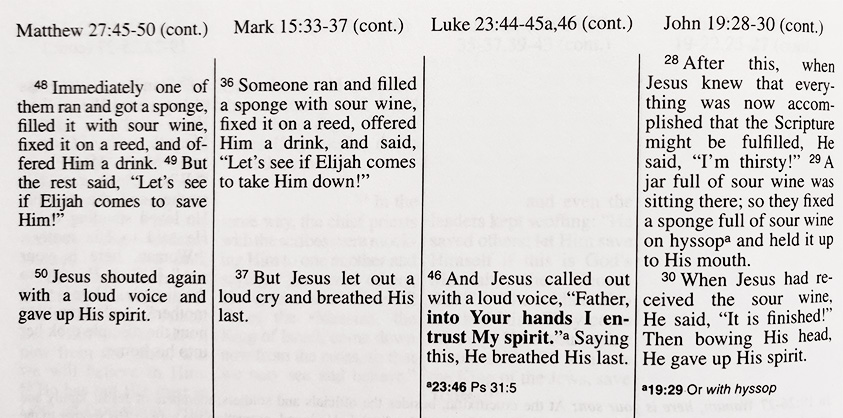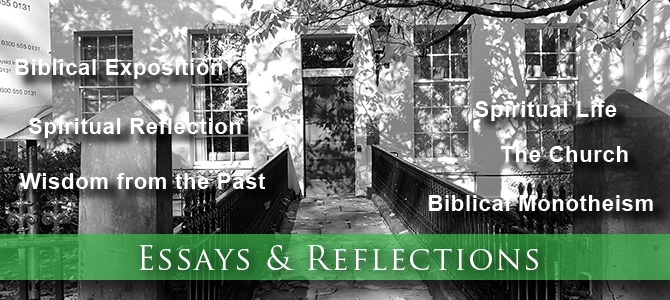You are here
Reading the Bible for Easter
Click on the picture for the full list of essays
Reading the Bible for Easter
Bentley C.F. Chan
It is the tradition of churches all around the world to read, on Easter Sunday, a gospel account of the resurrection of our Lord Jesus Christ. The public reading would usually be taken from Matthew 28, Luke 24, or John 20, and less often from Mark 16 due to the textual uncertainty of the latter part of the chapter.
But just as important as the public reading of Scripture is the private reading for every Christian.
I would like to share with you a way of reading the Bible during Good Friday and Easter, and offer seven practical tips. This way of reading the Bible for Easter works well for me and hopefully for you too. And you probably have a few good tips of your own.
The word “Easter” is unbiblical
But I need to clear away an obstacle: the word Easter itself. When I was a young Christian, I would sometimes wonder why the resurrection event was called Easter. To me it was a strange term that had no obvious connection to the resurrection of Jesus. Is it somehow derived from easterly, that is, in the eastward direction? (No, it is not.)
“Easter” is not found in any mainstream English Bible except the King James Bible, which uses “Easter” only once, in Acts 12:4, to refer to the Passover. But KJV’s use of “Easter” in Acts 12:4 is anomalous because the KJV, outside this verse, never translates the Greek pascha again as “Easter” but always as “Passover” (28 times).
Years later I learned that “Easter” is derived from Eostre, the name of an Old English or Germanic goddess. The etymology troubled me, so I eventually came to prefer the term “Resurrection Day” which I find more meaningful and faithful to the biblical concept. In fact, Resurrection Day is the term for Easter in a few languages such as Chinese (in which the term is 复活节), Vietnamese, Japanese, and Serbian.
But “Easter” is so entrenched in English that all alternative terms are unclear and ambiguous. That is why I use the word “Easter” in the title of this article—for clarity.
As for “Good Friday,” this term simply means “holy Friday” because “good” can mean “holy” in Old English. That is why the Holy Bible is sometimes called “the good book”. I have no objections to the term Good Friday, though some Christians believe that Jesus was crucified on a day other than Friday.
In any case, here are seven tips for reading the Bible for Good Friday and Easter.
1. Read these thirteen chapters from the four gospels
These 13 chapters are Matthew 26, 27, 28; Mark 14, 15, 16; Luke 22, 23, 24; and John 18, 19, 20, 21. They cover not only the resurrection of the Lord Jesus but also his arrest, trial, and crucifixion, thus providing us with a grand view of the Lord’s days before and after his resurrection.
2. But if that is too much for you, just read from Matthew and Luke
The 13 chapters have a total of 618 verses if we include the longer ending of Mark (it makes a difference of only 11 verses). But if that is too much reading for you, I would suggest reading from Matthew and Luke, which have a total of 341 verses in the six chapters.
Why these two books? It is subjective. Matthew happens to be my favorite gospel, and happens to give a solid account of the events we are looking into: the betrayal, the trial, the crucifixion, and the resurrection of our Lord Jesus.
But no gospel stands alone, so it would be good to supplement Matthew with another.
Mark’s account is somewhat brief, and there is debate over the textual reliability of the final part of Mark 16, from verses 9 to 20.
For me it is a choice between Luke or John, and again it is subjective. Luke records some statements that touch my heart most deeply. It is the only gospel in which Jesus says, “Father, forgive them, for they do not know what they are doing” (Luke 23:34), and the only gospel that records Jesus’ appearance on the road to Emmaus (24:13-35), an event that has shaped the way I perceive his heart. But John’s gospel also has touching narratives such the restoration of Peter, and Jesus’ dialogue with Pilate that culminated in the words, “What is truth?” (John 18:38).
But why not read from all four gospels for a full quadraphonic experience?
3. Refrain from reading from a Harmony of the Gospels
A “Harmony of the Gospels” is a book (or e-book) that arranges the text of the four gospels in table format, displaying their parallel passages (and also passages that are similar) side by side, so that the reader can easily compare them. Here is a photo of my copy of such a book:

A harmony of the gospels is one of the most useful tools for studying the gospels, but I would suggest that we refrain from using it for our Easter Bible reading because it causes our minds to start analyzing.
4. Don’t read too analytically
Our minds are analytical by nature, and this could hamper our Easter Bible reading which is meant to draw us into a spiritual connection with our Lord in his trial, crucifixion, and resurrection. Hence for our Easter reading, I don’t recommend reading from a harmony of the gospels or a study Bible, though there is a time and place for these Bible study tools.
You also don’t need a map to follow the events in your Bible reading, though you may wish to locate Bethany, Gethsemane, and the residence of the high priest on a map beforehand.
Most importantly, don’t start analyzing the apparent contradictions between the four gospels which arose because the four authors were writing from four different perspectives in their own writing styles. You may see some apparent contradictions regarding the day of the week, or the hour of the day, or who confronted Peter in his denials of Jesus.
You can always revisit these issues later on. Excellent essays on these gospel issues can be found in The HCSB Harmony of the Gospels (2003, Holman), such as the essay titled, “The Day, Hour and Year of Jesus’ Crucifixion”.
5. Learn something new from your reading
Whenever I read the Bible, I would often discover something new that I hadn’t seen before. Here is something new that I learned from my recent Easter Bible reading, in Matthew 27:50-53:
50 And Jesus cried out again with a loud voice and yielded up his spirit. 51 And behold, the curtain of the temple was torn in two, from top to bottom. And the earth shook, and the rocks were split. 52 The tombs also were opened. And many bodies of the saints who had fallen asleep were raised, 53 and coming out of the tombs after his resurrection they went into the holy city and appeared to many. (ESV)
I previously had not read this passage carefully, but this time I saw that the saints could have been raised right after Jesus had died, but they waited in their tombs until after his resurrection before coming out to meet the people in Jerusalem! At least that is a possible reading of the event, though the event itself is of secondary importance to me.
Even where a detail is not new to you, you can gain deeper spiritual insight into it. In my Easter reading, I reflected over the following:
- Jesus calls his disciples “my brothers” (Mt.28:10; John 20:17)
- “I bestow on you a kingdom, just as my Father bestowed one on me” (Luke 22:29)
- “All authority in heaven and on earth has been given to me” (Matthew 28:18)
6. You can read these chapters any day of the year
You don’t need to limit yourself to Good Friday or Easter Sunday for reading from the aforementioned chapters in the four gospels.
7. Think of one area where you can be transformed
Jesus’ resurrection is not only about himself but also about us. His resurrection is the first fruits of those who belong to Christ (1Cor.15:20,23). We are reconciled to God by the death of his Son, but are saved much more by his life (Rom.5:10). If we have been united with Christ in the likeness of his death, we will live in the likeness of his resurrection (Rom. 6:5).
Since we participate in the resurrection life of Jesus, now is the time to think of one area of our lives where we could undergo deeper transformation, perhaps in our speech, our conduct, or our love for humankind, by the grace of the risen Lord!
(c) 2021 Christian Disciples Church

